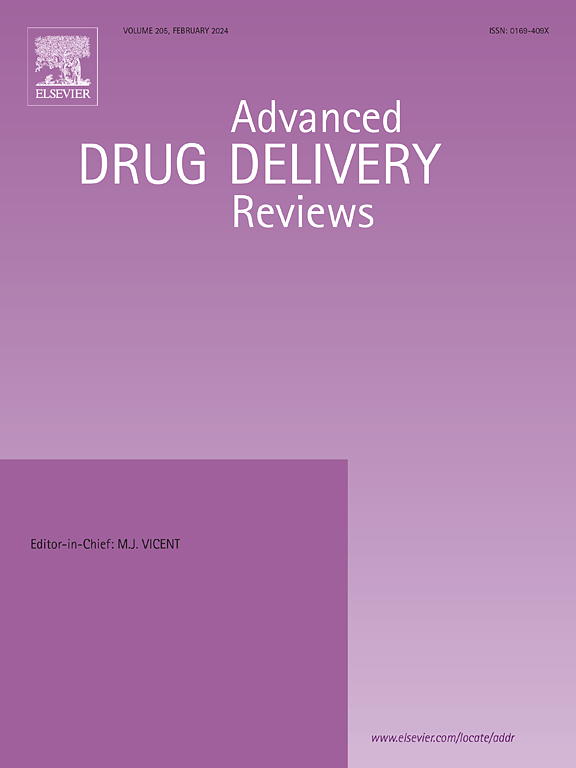针对神经退行性疾病中昼夜节律障碍的鼻内和吸入给药系统,观点和未来展望
IF 17.6
1区 医学
Q1 PHARMACOLOGY & PHARMACY
引用次数: 0
摘要
位于中枢神经系统(CNS)内的视交叉上核(SCN)驱动的内源性时钟与外源性时间线索的同步,对于维持昼夜节律、体内平衡和整体健康至关重要。昼夜节律紊乱与各种疾病有关,包括神经退行性疾病,如阿尔茨海默病和帕金森病。神经退行性疾病中昼夜节律障碍的传统药理学方法主要集中在口服给药。口服药物在实现必要的体循环以有效绕过血脑屏障(BBB)并到达中枢神经系统方面经常面临挑战,主要是由于低或可变的生物利用度。非侵入性给药方法的进步,如口服吸入和鼻内制剂,为靶向中枢神经系统提供了有希望的替代方案。通过增加生物利用度和快速起效,口服吸入和鼻内给药使药物迅速达到高体循环。此外,鼻内给药允许治疗绕过血脑屏障,通过嗅觉或三叉神经通路直接进入中枢神经系统。本综述评估了口服吸入和鼻内治疗神经退行性疾病中昼夜节律紊乱的潜力。此外,本综述将探讨褪黑激素作为一个例子,通过采用吸入或鼻内给药配方来提高药物吸收和更有效地靶向昼夜节律障碍,从而提高治疗效果。本文章由计算机程序翻译,如有差异,请以英文原文为准。


Intranasal and inhaled delivery systems for targeting circadian dysfunction in neurodegenerative disorders, perspective and future outlook
Synchronisation of the suprachiasmatic nucleus (SCN) driven endogenous clock, located within the central nervous system (CNS), and exogenous time cues, is essential for maintaining circadian rhythmicity, homeostasis and overall wellbeing. Disordered circadian rhythms have been associated with various conditions, inclusive of neurodegenerative disorders, such as Alzheimer’s disease and Parkinson’s disease. Traditional pharmacological approaches to circadian dysfunction in neurodegenerative disorders have primarily focused on oral drug delivery. Oral medications often face challenges in achieving the necessary systemic circulation to effectively bypass the blood brain barrier (BBB) and reach the CNS, primarily due to low or variable bioavailability. Advancements in non-invasive delivery methods, such as orally inhaled and intranasal formulations, present promising alternatives for targeting the CNS. Orally inhaled and intranasal drug delivery allows for medications to rapidly achieve high systemic circulation through increased bioavailability and fast onset of action. Additionally, intranasal delivery allows for therapies to bypass the BBB through the olfactory or trigeminal nerve pathways to directly enter the CNS. This review assesses the potential for orally inhaled and intranasal therapies to treat circadian disorders in neurodegenerative conditions. In addition, this review will explore melatonin as an example of enhancing therapeutic outcomes by adopting inhaled or intranasal drug delivery formulations to improve drug absorption and target circadian disorder more effectively.
求助全文
通过发布文献求助,成功后即可免费获取论文全文。
去求助
来源期刊
CiteScore
28.10
自引率
5.00%
发文量
294
审稿时长
15.1 weeks
期刊介绍:
The aim of the Journal is to provide a forum for the critical analysis of advanced drug and gene delivery systems and their applications in human and veterinary medicine. The Journal has a broad scope, covering the key issues for effective drug and gene delivery, from administration to site-specific delivery.
In general, the Journal publishes review articles in a Theme Issue format. Each Theme Issue provides a comprehensive and critical examination of current and emerging research on the design and development of advanced drug and gene delivery systems and their application to experimental and clinical therapeutics. The goal is to illustrate the pivotal role of a multidisciplinary approach to modern drug delivery, encompassing the application of sound biological and physicochemical principles to the engineering of drug delivery systems to meet the therapeutic need at hand. Importantly the Editorial Team of ADDR asks that the authors effectively window the extensive volume of literature, pick the important contributions and explain their importance, produce a forward looking identification of the challenges facing the field and produce a Conclusions section with expert recommendations to address the issues.

 求助内容:
求助内容: 应助结果提醒方式:
应助结果提醒方式:


